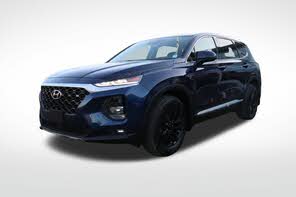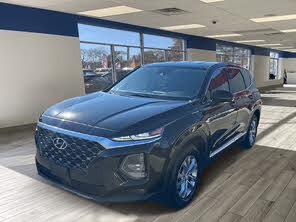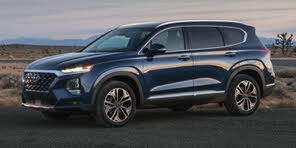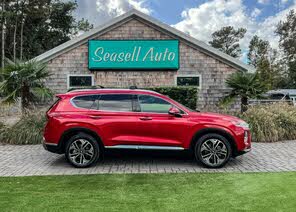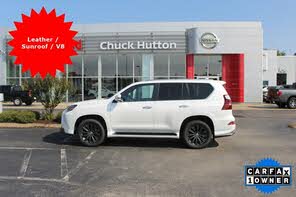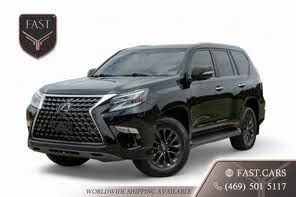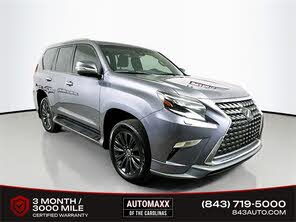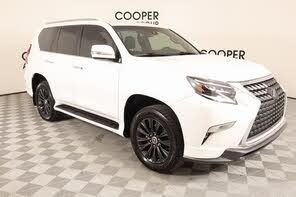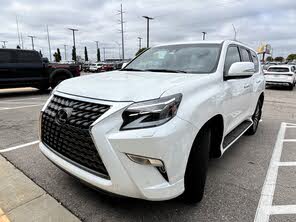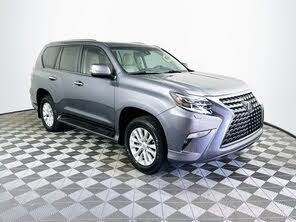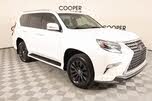2020 Hyundai Santa Fe vs 2021 Lexus GX
CarGurus highlights

According to CarGurus experts, the overall rating for the 2020 Hyundai Santa Fe is 8.8 out of 10, while the 2021 Lexus GX scores 5.3 out of 10. Based on these ratings, the 2020 Hyundai Santa Fe is the clear winner, offering a better blend of modern technology, comfort, and safety features. The Santa Fe is a more well-rounded choice for most consumers, while the GX is best suited for those with specific off-road and towing needs.
Choose the 2020 Hyundai Santa Fe if:
- You value a modern, tech-savvy infotainment system with Apple CarPlay and Android Auto.
- You need a comfortable, well-equipped interior with thoughtful storage solutions.
- You prioritize safety features and high safety ratings.
Choose the 2021 Lexus GX if:
- You require a vehicle with strong off-road capabilities and advanced off-road features.
- You need a traditional body-on-frame SUV with a high towing capacity.
- You prefer analog controls over touchscreen interfaces for ease of use.
Overview | |
MSRP$26,275 | MSRP$53,450 |
Average price$20,429 | Average price$44,252 |
Listings1129 | Listings404 |
Ratings & Reviews | |
User Reviews | User Reviews |
Expert reviews8.8 out of 10 | Expert reviews5.3 out of 10 |
Pros
| Pros
|
2020 Hyundai Santa Fe Reviews SummaryLast year, Hyundai changed its approach to the Santa Fe. The smaller five-passenger Santa Fe Sport got drop-kicked from the automaker’s lineup, replaced by this completely redesigned version of the SUV. The larger seven-passenger Santa Fe got a new name for one year (Santa Fe XL), and then the all-new 2020 Hyundai Palisade replaced that vehicle. With the Palisade’s arrival, there is just one Santa Fe for 2020, a five-passenger crossover that resides in a sweet spot between traditional compact and midsize models. It gets several updates, too, including a standard rear-seat reminder system, an available camera-based Blind-Spot View Monitor system, and new design accents to better distinguish the top trim level. | |
2021 Lexus GX Reviews SummaryMost modern SUVs are really car-based crossovers—lifted station wagons, or minivans without the sliding doors. That’s not the case with the 2021 Lexus GX 460. Like the mythical Loch Ness Monster, the GX is a creature that time forgot. It’s one of the last SUVs with truck-like body-on-frame construction and true off-road capability. That’s because the GX is actually a rebadged Toyota Land Cruiser Prado (a smaller version of the iconic Toyota Land Cruiser not sold in the United States), and is related to the Toyota 4Runner. It’s also genuinely old: the current generation dates back to the 2010 model year, and Lexus has kept it in production with some updates of styling and tech over the years. That makes the GX a fairly odd proposition on the new-car market. It has the off-road capability, not as a lifestyle statement, but because that’s what was still expected of SUVs when it was launched. The GX sits between the RX and LX in Lexus’ lineup but has little direct competition. Its only real rival is the much newer Land Rover Discovery. For the 2021 model year, the GX gets some minor updates, including a new Premium Plus Package, and acoustic front side glass. Lexus continues to offer only the GX 460 model, with a single powertrain option, standard four-wheel drive (4WD), and three trim levels: base, Premium, and Luxury. Our test car was the midlevel Premium version. | |
No video found | |
Popular Features & Specs | |
Engine2.4L 185 hp I4 | Engine4.6L 301 hp V8 |
Drive TrainFWD | Drive TrainAWD |
Seating Capacity5 | Seating Capacity7 |
Horsepower185 hp @ 6000 rpm | Horsepower301 hp @ 5500 rpm |
MPG City22 | MPG City15 |
MPG Highway29 | MPG Highway19 |
Engine | |
Engine Name2.4L 185 hp I4 | Engine Name4.6L 301 hp V8 |
Torque178 lb-ft @ 4000 rpm | Torque329 lb-ft @ 3500 rpm |
Horsepower185 hp @ 6000 rpm | Horsepower301 hp @ 5500 rpm |
DrivetrainFWD | DrivetrainAWD |
Fuel Economy | |
MPG City22 | MPG City15 |
MPG Highway29 | MPG Highway19 |
Interior | |
Seating Capacity5 | Seating Capacity7 |
Key Features | |
Sunroof/Moonroof | Sunroof/MoonroofOptional |
Safety | |
Front Crash Overall4 | Front Crash Overall |
Side Crash Overall5 | Side Crash Overall |
Dimensions & Capacity | |
Cargo Space35.9 cu ft | Cargo Space11.6 cu ft |
Curb Weight3591 lbs | Curb Weight5130 lbs |
Height66.1 in | Height74.2 in |
Length187.8 in | Length192.1 in |
Width74.4 in | Width74.2 in |
Wheelbase108.9 in | Wheelbase109.8 in |
Maximum Payload1138 lbs | Maximum Payload1315 lbs |
Number of doors4 | Number of doors4 |
Maximum Towing Capacity2000 lbs | Maximum Towing Capacity6500 lbs |
CarGurus highlights

According to CarGurus experts, the overall rating for the 2020 Hyundai Santa Fe is 8.8 out of 10, while the 2021 Lexus GX scores 5.3 out of 10. Based on these ratings, the 2020 Hyundai Santa Fe is the clear winner, offering a better blend of modern technology, comfort, and safety features. The Santa Fe is a more well-rounded choice for most consumers, while the GX is best suited for those with specific off-road and towing needs.
Choose the 2020 Hyundai Santa Fe if:
Shop Now- You value a modern, tech-savvy infotainment system with Apple CarPlay and Android Auto.
- You need a comfortable, well-equipped interior with thoughtful storage solutions.
- You prioritize safety features and high safety ratings.
Choose the 2021 Lexus GX if:
Shop Now- You require a vehicle with strong off-road capabilities and advanced off-road features.
- You need a traditional body-on-frame SUV with a high towing capacity.
- You prefer analog controls over touchscreen interfaces for ease of use.
Overview | ||
MSRP | $26,275 | $53,450 |
Average price | $20,429 | $44,252 |
Listings | ||
Ratings & Reviews | ||
User reviews | 4.5 | 4.6 |
Expert reviews | 8.8 out of 10Read full review | 5.3 out of 10Read full review |
Pros & cons | Pros
| Pros
|
Summary | Last year, Hyundai changed its approach to the Santa Fe. The smaller five-passenger Santa Fe Sport got drop-kicked from the automaker’s lineup, replaced by this completely redesigned version of the SUV. The larger seven-passenger Santa Fe got a new name for one year (Santa Fe XL), and then the all-new 2020 Hyundai Palisade replaced that vehicle. With the Palisade’s arrival, there is just one Santa Fe for 2020, a five-passenger crossover that resides in a sweet spot between traditional compact and midsize models. It gets several updates, too, including a standard rear-seat reminder system, an available camera-based Blind-Spot View Monitor system, and new design accents to better distinguish the top trim level. | Most modern SUVs are really car-based crossovers—lifted station wagons, or minivans without the sliding doors. That’s not the case with the 2021 Lexus GX 460. Like the mythical Loch Ness Monster, the GX is a creature that time forgot. It’s one of the last SUVs with truck-like body-on-frame construction and true off-road capability. That’s because the GX is actually a rebadged Toyota Land Cruiser Prado (a smaller version of the iconic Toyota Land Cruiser not sold in the United States), and is related to the Toyota 4Runner. It’s also genuinely old: the current generation dates back to the 2010 model year, and Lexus has kept it in production with some updates of styling and tech over the years. That makes the GX a fairly odd proposition on the new-car market. It has the off-road capability, not as a lifestyle statement, but because that’s what was still expected of SUVs when it was launched. The GX sits between the RX and LX in Lexus’ lineup but has little direct competition. Its only real rival is the much newer Land Rover Discovery. For the 2021 model year, the GX gets some minor updates, including a new Premium Plus Package, and acoustic front side glass. Lexus continues to offer only the GX 460 model, with a single powertrain option, standard four-wheel drive (4WD), and three trim levels: base, Premium, and Luxury. Our test car was the midlevel Premium version. |
Video | No video found | |
Popular Features & Specs | ||
Engine | 2.4L 185 hp I4 | 4.6L 301 hp V8 |
Drive Train | FWD | AWD |
Seating Capacity | 5 | 7 |
Horsepower | 185 hp @ 6000 rpm | 301 hp @ 5500 rpm |
MPG City | 22 | 15 |
MPG Highway | 29 | 19 |
Engine | ||
Engine Name | 2.4L 185 hp I4 | 4.6L 301 hp V8 |
Torque | 178 lb-ft @ 4000 rpm | 329 lb-ft @ 3500 rpm |
Horsepower | 185 hp @ 6000 rpm | 301 hp @ 5500 rpm |
Drivetrain | FWD | AWD |
Fuel Economy | ||
MPG City | 22 | 15 |
MPG Highway | 29 | 19 |
Interior | ||
Seating Capacity | 5 | 7 |
Key Features | ||
Sunroof/Moonroof | Optional | |
Safety | ||
Front Crash Overall | 4 | |
Side Crash Overall | 5 | |
Dimensions & Capacity | ||
Cargo Space | 35.9 cu ft | 11.6 cu ft |
Curb Weight | 3591 lbs | 5130 lbs |
Height | 66.1 in | 74.2 in |
Length | 187.8 in | 192.1 in |
Width | 74.4 in | 74.2 in |
Wheelbase | 108.9 in | 109.8 in |
Maximum Payload | 1138 lbs | 1315 lbs |
Number of doors | 4 | 4 |
Maximum Towing Capacity | 2000 lbs | 6500 lbs |
When shopping for a new 2020 Hyundai Santa Fe, buyers chose between SE, SEL, and Limited trim levels. Versions with a “2.0T” in the trim name received a power and performance upgrade courtesy of a turbocharged engine. All-wheel drive (AWD) was an option, allowing the automatic transmission to transfer power from the front wheels to the rear wheels when necessary. Aside from deciding about AWD, a turbocharged engine, and—if opting for the SEL—an optional Convenience Package, buyers picked a paint color, interior color, and upgrades from a shortlist of dealer-installed accessories. The test vehicle had Limited 2.0T trim and dealer-installed floor mats, bringing the price to $39,170.
The Santa Fe's design was bold and experimental, which might not have appealed to everyone. Controversial elements included the grille shape, stacked front lighting elements, asymmetrical fender stampings, and oversized rear “skid plate” trim. Inside, the dual-cowl dashboard design swept into door panels with diamond-textured speaker grilles, and versions with gray or beige interiors presented a high-contrast visual feast. However, materials quality didn’t quite match the high-style design, with glossy plastic covering the lower half of the interior and fairly stiff leather seat upholstery. Build quality was exceptionally good, and the controls operated with refinement.
The Lexus GX 460’s styling was a product of its long time on the market, retaining the same basic body shell from a decade ago with a few updates over the years. The GX got Lexus’ trademark spindle grille for the 2014 model year, updated for 2020 with a new textured insert and new triple-beam LED headlights. The 2021 model didn’t get any styling changes, but silver 18-inch wheels became standard on the Premium trim level. Despite not being originally designed around the spindle grille, the styling was remarkably coherent, and the GX’s tough, aggressive look was distinctive.
While Lexus kept the exterior styling up to date, the interior didn’t feel up to the standards of a modern luxury SUV. The Premium test car’s wood trim looked and felt like molded plastic, and there was plenty of actual plastic as well. At least standard leather upholstery was included, with semi-aniline leather on the range-topping Luxury trim level. The upright dashboard and high center console left very little legroom, and the steering wheel was positioned at an odd angle, making the driving experience feel like operating a bus. However, the dashboard shape and boxy profile produced excellent outward visibility, particularly helpful when parking or off-roading.
The 2020 Hyundai Santa Fe had a minimum curb weight of 3,591 pounds and a maximum of 3,946 pounds. The standard 185-horsepower 2.4-liter four-cylinder engine was not ideal for this weight. Instead, the turbocharged 2.0-liter four-cylinder engine, producing 235 hp and 260 lb-ft of torque between 1,450 rpm and 3,500 rpm, was the better choice. This engine provided significant increases in power and torque over the standard engine, and the torque was available much faster. The eight-speed automatic transmission funneled power to the front wheels unless the optional AWD system was chosen. The test vehicle had FWD and suffered from torque steer under hard acceleration, an issue that disappeared with AWD. Properly equipped, the Santa Fe had a towing capacity of 3,500 pounds.
Fuel economy for the Santa Fe 2.0T front-driver was rated at 23 mpg in combined driving by the EPA, and the test model returned 22.1 mpg. The Santa Fe offered a smooth ride, decent handling, light-effort steering, and brakes that withstood some abuse while providing clean stops. The Limited trim had laminated windshield and front window glass, making the highway ride quiet. The Santa Fe handled moderate off-roading with ease but didn’t inspire driver engagement, making it more of a practical tool than a fun toy.
The 2021 Lexus GX 460 kept it simple with a 4.6-liter V8 engine producing 301 horsepower and 329 pound-feet of torque, coupled to a six-speed automatic transmission. The GX 460’s 5,130 pounds made their presence felt at higher speeds, requiring careful planning for merging and overtaking maneuvers. Bringing the SUV to a stop also required advanced planning, and the ride quality was typical of a body-on-frame vehicle, meaning it wasn’t very good. The Premium test car lacked the adaptive suspension of the Luxury trim level, making it hard to civilize the ride.
The GX 460 excelled in off-road capability, equipped with a Torsen center differential that normally split torque 40/60 front to rear but could be fully locked for a 50/50 split. The standard 4WD system had a low range for off-road trails, and the GX included driver aids like hill-descent control and hill-start assist. The optional Off-Road Package for the Luxury trim level added features like a transmission cooler, fuel-tank protector, multi-view camera system, Crawl Control, and Multi-Terrain Select. The GX 460 had a maximum towing capacity of 6,500 pounds and stability control with a trailer-sway control function.
The 2020 Hyundai Santa Fe offered thoughtful attention to detail, with creative storage spaces and stain-resistant fabric in versions with cloth seats. The test vehicle had eight-way power-adjustable, heated, and ventilated front seats, with the driver’s seat including four-way power-adjustable lumbar support and an extending thigh support. The test model also included a heated steering wheel. The Santa Fe’s dual-zone automatic climate control system included a Clean Air ionizer, and the air conditioning was effective even with the massive panoramic glass sunroof.
The back seat was comfortable for adults, with air conditioning vents, rear side-window sunshades, and heated bottom cushions in the Limited trim level. Legroom and thigh support made it a good place to spend time, and the rear seats reclined for added comfort. However, the Santa Fe stumbled with cargo space, offering 35.9 cubic feet behind the rear seat and a maximum of 71.3 cubic feet. Large storage compartments under the cargo floor were a positive note, and the hands-free “smart” liftgate was a convenient feature.
The 2021 Lexus GX’s interior ergonomics betrayed its age, with an upright dashboard and high center console leaving little legroom. The steering wheel was positioned at an odd angle, making the driving experience feel like operating a bus. The dashboard shape and boxy profile produced excellent outward visibility, particularly helpful when parking or off-roading. However, forward visibility was limited due to the tall hood.
The center-console storage bin was small, as were the cupholders and in-door bottle holders in all three rows. The second-row cupholders took up a lot of space in the fold-down armrest. The array of buttons and knobs for climate control and seat heaters were easier to use than touchscreen-based controls in other luxury SUVs. The GX came standard with three rows and seating for seven, with a power-folding third row available on the Premium with the new-for-2021 Premium Plus Package and standard on the Luxury trim level. However, the third row was best reserved for children, and accessing it was difficult. The GX had 64.7 cubic feet of cargo space with the second and third-row seats folded, substantially less than the Discovery’s 73.0 cubic feet. With the third row up, cargo space was minimal.
The 2020 Hyundai Santa Fe’s touchscreen infotainment system was a shining example of this technology done right. It had stereo control knobs, main menu shortcut buttons, a programmable button, Bluetooth connectivity, and Apple CarPlay and Android Auto smartphone integration. The SEL trim added SiriusXM satellite radio with a free three-month subscription and Blue Link connected services with three free years of service, including remote engine starting, automatic emergency assistance, and more.
The Limited trim added a larger 8-inch display, a navigation system, a surround-view camera, wireless smartphone charging, and a 12-speaker Infinity surround sound system. Technology unrelated to the infotainment system included a head-up display providing data on the windshield within the driver’s line of sight. The voice recognition system was sophisticated, responding to naturally spoken commands with little trouble.
The 2021 Lexus GX was light on tech features, with standard Bluetooth, Amazon Alexa, and Google Assistant connectivity, but no Apple CarPlay or Android Auto compatibility. Two USB ports for each of the first two rows were standard, but the third row didn’t get any. A 17-speaker Mark Levinson audio system was available. The standard infotainment system had outdated graphics and limited functions, with a seven-segment display for time and temperature below the main screen.
The good news was that the touchscreen wasn’t necessary for most functions, as Lexus included analog controls for nearly everything, including large shortcut buttons for the screen’s menus. While this was a primitive interface for a luxury vehicle, it was a refreshing antidote to the screen-centric approaches of most other new luxury SUVs.
The 2020 Hyundai Santa Fe was a great choice for a safe family SUV, earning a five-star overall crash-test rating from the National Highway Traffic Safety Administration (NHTSA) and a Top Safety Pick rating from the Insurance Institute for Highway Safety (IIHS). Every Santa Fe was equipped with a slew of safety features, including adaptive cruise control, forward collision warning, automatic emergency braking, lane-departure warning, and lane-keeping assistance. A driver monitoring system and a rear-seat reminder system were also standard.
The SEL trim added blind-spot warning, rear cross-traffic warning, and a safe exit assist system. The SEL Convenience Package equipped the SUV with an ultrasonic occupant alert system tied to the owner’s Blue Link smartphone app. The Limited trim included a new Blind-Spot View Monitor, showing a live video feed of the blind spots in the center of the instrument cluster.
The 2021 Lexus GX 460 hadn’t been rated by the NHTSA or IIHS. The GX 460 came with the Lexus Safety System+ bundle of driver aids as standard equipment, including forward-collision warning with pedestrian detection, automatic emergency braking, automatic high beams, lane-departure warning, and adaptive cruise control. Blind-spot monitoring and rear cross-traffic alert were also standard. However, the GX 460 missed out on some safety features available in other Lexus models, such as traffic-sign recognition and Lane Tracing Assist automated lane centering.

By: CarGurus + AI
At CarGurus, our team of experienced automotive writers remain at the heart of our content operation, conducting hands-on car tests and writing insightful guides that are backed by years of industry experience. To complement this, we are harnessing AI to make our content offering more diverse and more helpful to shoppers than ever. To achieve this, our AI systems are based exclusively on CarGurus content, ratings and data, so that what we produce is both unique to CarGurus, and uniquely helpful to car shoppers.

